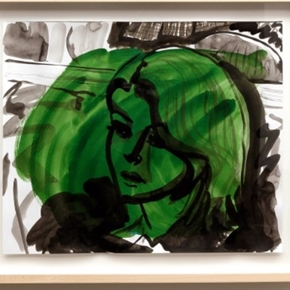There is a fundamental aspect of appreciating art that seems to be missing from some of the major art fairs. At metropolitan hubs like New York, Miami or Los Angeles, it is often just as important to be seen as it is to see the works on view. Price tags can often outweigh the paintings or sculptures they are attached to. But that is not the case at the Dallas Art Fair.
“There is a true relationship with beauty and emotion and the art here in Dallas,” says Dominique Toutant, the director of Galerie Blouin Division. People are looking at the art itself and are not so concerned with the name, the brand or the investment. And that is okay.” Toutant’s gallery, which is based in Montreal and Canada, has participated for six years, nearly half the life of the fair which this year is in its 14th edition. He says part of the joy of the fair is that, unlike more mainstream fairs, visitors often take their time walking around and come back multiple times. They breathe in the art as opposed to binging on it.
Much of this style of appreciation can be attributed to the Southern pace of life in Dallas. People here walk more slowly than in other parts of the US. The voyage is as much a part of the trip as the destination and should be treated as such. That point becomes clear after a few minutes of walking around the fair, which returned this year to the Fashion Industry Galery. Upon entering one is greeted by a commissionaire pushing a rolling cart form which they serve piping hot coffee and cold iced tea.
All this, by the way, is free. Hard to imagine such a thing in Miami or New York. But that is Southern hospitality.
That kind of warmth is hard to find, especially in the art world, but in Dallas it defines the art scene. As a result of the coronavirus pandemic shifting the workforce landscape, thousands of people moved to east Texas from metropolitan landmarks like New York, Los Angeles or Chicago. They came for cheaper rent, better opportunities and a more agreeable pace of life. Dallas saw close to 100,000 people move in to the city between 2020 and 2021. According to the San Antonio Business Journal over 40% of domestic migration comes from California.
“It’s great to have grown up in a city where you feel like you know everyone, then suddenly it feels like a brand-new city,” says Hilary Fagadau, co-owner of the Dallas-based 12.26 gallery. Fagadau owns 12.26 with her sister, Hannah. Apart from being one of the most well-respected young galleries in Dallas, the sisters were almost predisposed to selling art—their grandmother, Jeanne Fagadau, for years sold blue-chip prints out of her Dallas home.
“One result of the pandemic was that many of the young people, who were already moving to Texas for their careers or for a more affordable life, found themselves with more disposable income,” Hannah says. “They couldn’t go on trips or spend money on lavish dinners. Instead, they caught the collecting bug. But it’s always very considered, very intentional collecting. It’s for the love of the art.”
“For years the market has changed in a way that excludes the middle-class collector,” the gallerist Cris Worley says. “Especially after 2008, it was only the very wealthy that could drive the market. Now, things are changing. People are moving to more affordable cities because their jobs have moved to the remote model. They can go wherever they want. Starting in the summer of 2020 people started showing up to the gallery saying, ‘I just moved here from California, from Chicago, from New York’. So many people are starting to collect art because now they have the means to. And these new collectors, they buy art because it moves them, not because of how much it sold for at auction last season. They buy art because they are in love the formal elements, because they love it."


